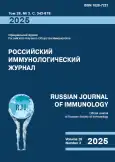Оценка изменений профилей метаболитов в клетках микроглии SIM-A9 под действием гипоксии и липополисахарида
- Авторы: Бобров М.Ю.1, Никитин В.С.1, Бурак М.Ю.1, Афонин М.Б.1
-
Учреждения:
- АНОО ВО «Научно-технологический университет “Сириус”»
- Выпуск: Том 28, № 3 (2025)
- Страницы: 553-560
- Раздел: КРАТКИЕ СООБЩЕНИЯ
- URL: https://journal-vniispk.ru/1028-7221/article/view/319900
- DOI: https://doi.org/10.46235/1028-7221-17212-EOC
- ID: 319900
Цитировать
Полный текст
Аннотация
В развитии нейровоспаления ведущую роль играют клетки микроглии. Активация микроглии приводит к формированию реактивных фенотипов, которые могут как способствовать развитию нейровоспаления, так и обеспечивать его разрешение. При активации микроглии происходит метаболическое репрограммирование или изменение активности путей метаболизма и содержания метаболитов, поддерживающих тот или иной фенотип. Возможность фенотипического переключения за счет метаболомного репрограммирования может иметь несомненный терапевтический потенциал, однако в настоящее время имеются ограниченные данные об изменении состава метаболитов и активности метаболических путей в клетках микроглии под действием нейровоспалительных факторов. В этой связи целью данной работы явилось проведение нетаргетного метаболомного исследования для оценки изменений профилей метаболитов в клетках линии микроглии SIM-A9 подвергнутых гипоксии, а также при активации TLR4. Профилирование метаболитов в экстрактах клеток, подвергнутых действию гипоксии или липополисахарида проводили с использованием высокоэффективной жидкостной хроматографии и масс-спектрометрии высокого разрешения, с последующим биоинформатическим анализом данных. Результаты проведенных исследований свидетельствуют о том, что гипоксическое воздействие, а также стимуляция TLR4 приводят к заметным перестройкам метаболизма клеток микроглии. При этом характер данных перестроек зависит от типа стрессорного воздействия и его длительности. Изменение активности путей метаболизма глутатиона и аргинина может служить маркером поляризации клеток микроглии после гипоксического воздействия. Активация TLR4 под действием липополисахарида приводит к модулированию путей, ассоциированных с энергетическим обменом, а также изменению путей метаболизма ароматических аминокислот. Можно заключить, что использованный в данной работе подход позволит в дальнейшем исследовать динамику метаболических изменений под действием провоспалительных факторов различной природы и детализировать их роль в метаболическом репрограммирования клеток микроглии на различных этапах развития нейровоспаления.
Ключевые слова
Полный текст
Открыть статью на сайте журналаОб авторах
Михаил Юрьевич Бобров
АНОО ВО «Научно-технологический университет “Сириус”»
Автор, ответственный за переписку.
Email: bobrov.my@talantiuspeh.ru
к.х.н., ведущий научный сотрудник направления «Иммунобиология и биомедицина» Научного центра генетики и наук о жизни
Россия, пгт Сириус, Краснодарский крайВ. С. Никитин
АНОО ВО «Научно-технологический университет “Сириус”»
Email: bobrov.my@talantiuspeh.ru
лаборант-исследователь, студент магистратуры (направление «Иммунобиология и биомедицина»)
Россия, пгт Сириус, Краснодарский крайМ. Ю. Бурак
АНОО ВО «Научно-технологический университет “Сириус”»
Email: bobrov.my@talantiuspeh.ru
лаборант-исследователь, студент магистратуры (направление «Иммунобиология и биомедицина»)
Россия, пгт Сириус, Краснодарский крайМ. Б. Афонин
АНОО ВО «Научно-технологический университет “Сириус”»
Email: bobrov.my@talantiuspeh.ru
главный инженер-исследователь ресурсного центра аналитических методов
Россия, пгт Сириус, Краснодарский крайСписок литературы
- Chen B., Di B. Endogenous Ligands of TLR4 in microglia: potential targets for related neurological diseases. Curr. Drug Targets, 2024, Vol. 25, no. 14, pp. 953-970.
- Fan H., Bai Q., Yang Y., Shi X., Du G., Yan J., Shi J., Wang D. The key roles of reactive oxygen species in microglial inflammatory activation: Regulation by endogenous antioxidant system and exogenous sulfur-containing compounds. Eur. J. Pharmacol., 2023, Vol. 956, 175966. doi: 10.1016/j.ejphar.2023.175966.
- Hestad K., Alexander J., Rootwelt H., Aaseth J.O. The role of tryptophan dysmetabolism and quinolinic acid in depressive and neurodegenerative diseases. Biomolecules, 2022, Vol. 12, no. 7, 998. doi: 10.3390/biom12070998.
- Iskusnykh I.Y., Zakharova A.A., Pathak D. Glutathione in brain disorders and aging. Molecules, 2022, Vol. 27, no. 1, 324. doi: 10.3390/molecules27010324.
- Li S., Park Y., Duraisingham S., Strobel F.H., Khan N., Soltow Q.A., Jones D.P., Pulendran B. Predicting network activity from high throughput metabolomics. PLoS Comput. Biol., 2013, Vol 9, no. 7, e1003123. doi: 10.1371/journal.pcbi.1003123.
- Liu Y., Wu L., Peng W., Mao X. Glial polarization in neurological diseases: Molecular mechanisms and therapeutic opportunities. Ageing Res. Rev., 2025, Vol. 104, 102638. doi: 10.1016/j.arr.2024.102638.
- Nair S., Sobotka K.S., Joshi P., Gressens P., Fleiss B., Thornton C., Mallard C., Hagberg H. Lipopolysaccharide-induced alteration of mitochondrial morphology induces a metabolic shift in microglia modulating the inflammatory response in vitro and in vivo. Glia, 2019, Vol. 67, no. 6, pp. 1047-1061.
- Ock J., Jeong J., Choi W.S., Lee W.H., Kim S.H., Kim I.K., Suk K. Regulation of Toll-like receptor 4 expression and its signaling by hypoxia in cultured microglia. J. Neurosci. Res., 2007, Vol. 85, pp. 1989-1995.
- Rana A.K., Bhatt B., Gusain C., Biswal S.N., Das D., Kumar M. Neuroimmunometabolism: how metabolism orchestrates immune response in healthy and diseased brain. Am. J. Physiol. Endocrinol. Metab., 2025, Vol. 328, no. 2, pp. E217-E229.
- Tyrtyshnaia A, Konovalova S, Bondar A, Ermolenko E, Sultanov R, Manzhulo I. Anti-inflammatory activity of N-Docosahexaenoylethanolamine and N-eicosapentaenoylethanolamine in a mouse model of lipopolysaccharide – induced neuroinflammation. Int. J. Mol. Sci., 2021, Vol. 22, no. 19, 10728. doi: 10.3390/ijms221910728.
- Wang Y., Leak R.K., Cao G. Microglia-mediated neuroinflammation and neuroplasticity after stroke. Front. Cell. Neurosci., 2022, Vol. 16, 980722. doi: 10.3389/fncel.2022.980722.
- Wang Z., Zhu H., Xiong W. Advances in mass spectrometry-based multi-scale metabolomic methodologies and their applications in biological and clinical investigations. Sci. Bull. (Beijing), 2023, Vol. 68, no. 19, pp. 2268-2284.
- Yang S., Qin C., Hu Z.W., Zhou L.Q., Yu H.H., Chen M., Bosco D.B., Wang W., Wu L.J., Tian D.S. Microglia reprogram metabolic profiles for phenotype and function changes in central nervous system. Neurobiol. Dis., 2021, Vol. 152, 105290. doi: 10.1016/j.nbd.2021.105290.
- Yao L., Kan E.M., Lu J., Hao A., Dheen S.T., Kaur C., Ling E.A. Toll-like receptor 4 mediates microglial activation and production of inflammatory mediators in neonatal rat brain following hypoxia: role of TLR4 in hypoxic microglia. J. Neuroinflammation, 2013, Vol. 10, 23. doi: 10.1186/1742-2094-10-23.
Дополнительные файлы








